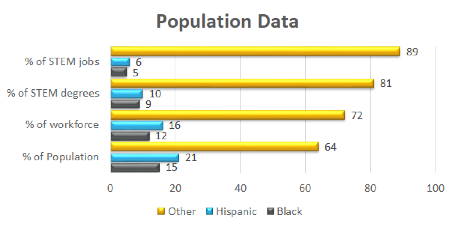Problem
In the United States, jobs in Science, Technology,Engineering and Math (STEM) disciplines have grown at a rate of 24% (2007-2017) versus a 4% growth rate in other occupations. The STEM education pipeline is not keeping pace with this demand and employers are struggling to fill open positions. U.S. government reports indicate that nearly 60% of employers are unable to fill STEM vacancies within 12 weeks and are projecting a shortage of nearly 3.5 million STEM professionals by 2025.
Further, STEM education can help break the cycle of poverty and create new opportunities for many underserved populations and communities as STEM occupations out-earn non-STEM fields by 12-30% across all education levels.
Solution
Bold immediate action and long-term commitments are needed to increase diversity and inclusion into the STEM talent pipeline and help address these chronic inequities. Women make up only 28% of the STEM workforce and men vastly outnumber women majoring in STEM college curriculum. Women representation in pure engineering is even lower (15.7%). Black and Hispanic professionals are even more severely underrepresented in STEM disciplines. As shown in Figure 1, Black and Hispanic people represent over 36% of the U.S. population but only 11% of STEM jobs.

Implementation
The current STEM education pipeline is not filling this gap.Girls and women are systematically tracked away from science and math throughout their education, limiting their training and options to go into these fields as adults. One-third of minority students fall out; a rate twice that of other students, and many underrepresented high school students simply lack the means, role models and belief that STEM success is accessible and achievable for them.
It is clear that—to meet the needs of industry and to help solve this chronic societal inequity—an expanded and more diverse workforce will be required as we move into the Fourth Industrial Revolution. Industry has recognized this need for diversity and inclusion in the workplace as evidenced by over 1,600 business leaders having signed on to the CEO Action for Diversity and Inclusion™ pledge since 2017. They clearly understand that organizations with diverse teams perform better, stating:
“We recognize that diversity and inclusion are multifaceted issues and that we need to tackle these subjects holistically to better engage and support all underrepresented groups within business. To do this, we believe we also need to address honestly and head-on the concerns and needs of our diverse employees and increase equity for all, including Blacks, Latinos, Asians, Native Americans, LGBTQ, disabled, veterans and women.”
In Michigan, diversity, equity and inclusion is at the forefront for many employers. For example, BorgWarner, an automotive supplier headquartered in Auburn Hills, says it is dedicated to cultivating a diverse workforce.
“In order to do so, we need to take action at the student level and help talented, bright, diverse minds overcome the barriers they are facing to achieve their goals known and not yet known,” said Felecia Pryor, executive vice president and chief human resources officer at BorgWarner.
Outcome
In 2020, Kettering University, through its STEM Gateway to Workforce Diversity Initiative, began working with BorgWarner, among other industry partners, to provide gateway opportunities for minorities that foster and promote curiosity, provide and leverage educational resources and focus on career transitions into STEM fields for the long-term.
BorgWarner made a generous $1 million donation in February 2021 to create a BorgWarner Scholars fund supporting underrepresented students and providing seed funding to help this overall initiative progress. The university is actively engaged in discussions with many other companies in pursuit of additional corporate partners and sponsors. The effort was championed by a Kettering graduate, Brady Ericson, who is vice president of BorgWarner and president and general manager of Morse Systems.
Kettering’s Office of Multicultural Student Initiatives (OMSI) has a highly successful track record in this arena, applying proven best practice and individualized support to achieve success. This has resulted in a30% higher graduation rate of Black and Hispanic students compared to other STEM institutions (85% vs. 66%). The university has a unique 5-year Co-op model that assures students, university, and corporate continuity throughout the process and prepares students for academic, career and life success through seamless academic, career and social support and mentorship.
Kettering has identified several critical elements essential to STEM education success for underrepresented students, including:
· Enabling early student and parental exposure toSTEM fields
· Overcoming financial and social barriers
· Mentoring continuity to minimize student drop-out rates
· Implementing a multi-company approach
· Adopting a long-term play requiring a long-term commitment.
Benefits of Kettering’s broad, multi-company approach are abundantly clear, and can be summarized in two statements:
· The societal and individual impact – it’s the right thing to do
· And shareholder value – more diverse workforces perform better.
Moving forward, Kettering University seeks to partner with abroad range of companies to substantially increase the number of underrepresented students attracted to and entering the university. The school aims to successfully graduate a more diverse student body with a world-leading STEM education and little-to-no student debt so they may become gainfully employed in a meaningful and value-adding career.

